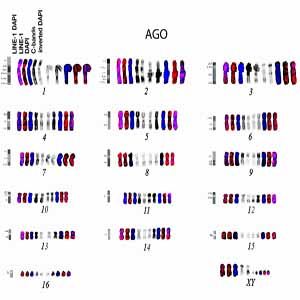Retrotransposon mapping in spider monkey genomes of the family Atelidae (Platyrrhini, Primates) shows a high level of LINE-1 amplification

Accepted: October 2, 2022
All claims expressed in this article are solely those of the authors and do not necessarily represent those of their affiliated organizations, or those of the publisher, the editors and the reviewers. Any product that may be evaluated in this article or claim that may be made by its manufacturer is not guaranteed or endorsed by the publisher.
Authors
To investigate the distribution of LINE-1 repeat sequences, a LINE-1 probe was Fluorescence In Situ Hybridized (FISH) on the chromosomes of Ateles geoffroyi and Ateles fusciceps (Atelidae); a LINE-1 probe was also mapped on Cebuella pygmaea (Cebidae) and used as an outgroup for phylogenetic comparison. Ateles spider monkeys have a highly rearranged genome and are an ideal model for testing whether LINE-1 is involved in genome evolution. The LINE-1 probe has been mapped in the two Atelidae species for the first time, revealing a high accumulation of LINE-1 sequences along chromosomal arms, including telomeres, and a scarcity of LINE-1 signals at centromere positions. LINE-1 mapping in C. pygmaea (Cebidae) revealed signals at centromere positions and along chromosome arms, which was consistent with previous published data from other Cebidae species. In a broader sense, the results were analyzed in light of published data on whole-chromosomal human probes mapped in these genomes. This analysis allows us to speculate about the presence of LINE-1 sequences at the junction of human chromosomal syntenies, as well as a possible link between these sequences and chromosomal rearrangements.
How to Cite

This work is licensed under a Creative Commons Attribution-NonCommercial 4.0 International License.
PAGEPress has chosen to apply the Creative Commons Attribution NonCommercial 4.0 International License (CC BY-NC 4.0) to all manuscripts to be published.

 https://doi.org/10.4081/jbr.2022.10725
https://doi.org/10.4081/jbr.2022.10725



